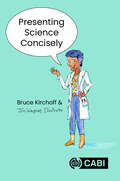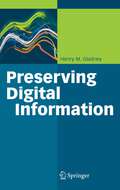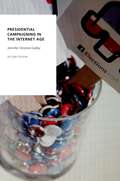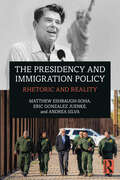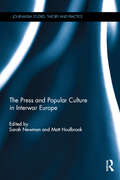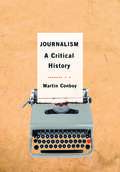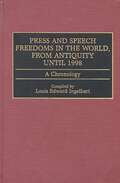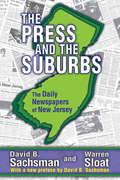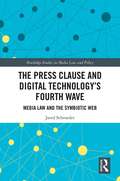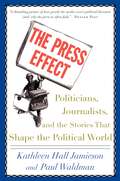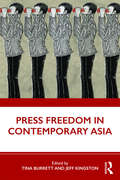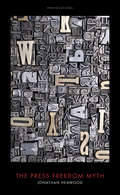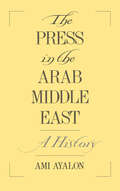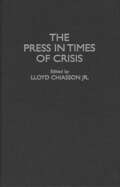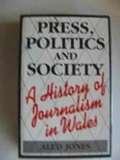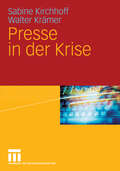- Table View
- List View
Presenting Science Concisely
by Dr Bruce KirchoffImagine you are a scientist faced with presenting your research clearly and concisely. Where would you go for help? This book provides the answer. It shows how to use story structure to craft clear, credible presentations. In it you will find exercises to help you give both short and long presentations. Elevator pitches, lightning talks, Three Minute Thesis (3MT®), and conference presentations are all covered as are suggestions for longer presentations. Separate chapters address good poster design, how to tailor your talk to an audience, and presentation skills. Throughout the book the focus is on creating surprising, memorable stories. Scientific presentations are true stories about new discoveries. They are surprising because every new discovery changes our understanding of the world, and memorable because they move audiences. The book also covers: · Randy Olson's And-But-Therefore (ABT) narrative form · Mike Morrison's Better Poster designs · Eye-tracking analyses of posters by EyeQuant · Numerous case studies and examples from different scientific fields · Links to videos of exemplary presentations With light-hearted illustrations by Jon Wagner this book will appeal to researchers and graduate students in all areas of science, and other disciplines too.
Presenting With Power: Captivate, Motivate, Inspire And Persuade
by Shay McconnonWritten by one of 'the most exciting keynote speakers in the UK', this is no ordinary book on presentations. Shay McConnon shares with you the secrets that professional speakers use to make a real impact and a memorable impression on their audience. Whether you are a novice or a seasoned pro - this book will give you tips and techniques that will take you to the next level.Advice includes: - Planning your presentation for maximum effect- Constructing your message- Choosing strong visual aids that will engage your audience- Open and close with impact- Handling a Q&A session- Never be boring again- How to handle the unexpected
Preserving Digital Information
by Henry GladneyCultural history enthusiasts have asserted the urgent need to protect digital information from imminent loss. This book describes methodology for long-term preservation of all kinds of digital documents. It justifies this methodology using 20th century theory of knowledge communication, and outlines the requirements and architecture for the software needed. The author emphasizes attention to the perspectives and the needs of end users.
PRESID CAMPAIGN IN INTER AGE 2E OSDP C (Oxford Studies in Digital Politics)
by Jennifer Stromer-GalleyAs the plugged-in presidential campaign has arguably reached maturity, Presidential Campaigning in the Internet Age challenges popular claims about the democratizing effect of Digital Communication Technologies (DCTs). Analyzing campaign strategies, structures, and tactics from the past six presidential election cycles, Stromer-Galley reveals how, for all their vaunted inclusivity and tantalizing promise of increased two-way communication between candidates and the individuals who support them, DCTs have done little to change the fundamental dynamics of campaigns. The expansion of new technologies has presented candidates with greater opportunities to micro-target potential voters, cheaper and easier ways to raise money, and faster and more innovative ways to respond to opponents. The need for communication control and management, however, has made campaigns slow and loathe to experiment with truly interactive internet communication technologies. Citizen involvement in the campaign historically has been and, as this book shows, continues to be a means to an end: winning the election for the candidate. For all the proliferation of apps to download, polls to click, videos to watch, and messages to forward, the decidedly undemocratic view of controlled interactivity is how most campaigns continue to operate. In the fully revised second edition, Presidential Campaigning in the Internet Age examines election cycles from 1996, when the World Wide Web was first used for presidential campaigning, through 2016 when campaigns had the full power of advertising on social media sites. As the book charts changes in internet communication technologies, it shows how, even as campaigns have moved from a mass mediated to a networked paradigm, the possibilities these shifts in interactivity seem to promise for citizen input and empowerment remain farther than a click away.
The Presidency and Immigration Policy: Rhetoric and Reality
by Matthew Eshbaugh-Soha Eric Gonzalez Juenke Andrea SilvaThis comprehensive analysis of presidential immigration rhetoric quantifies the frequency, tone, and efficacy of public mentions of immigrants and immigration policy by the presidents from Washington through Biden. The book also explores the intersection of the presidential role with that of the other key actors in the immigration policy system—notably the press, the public, and Congress. For students of immigration studies, presidential studies, and political communication, this book also poses the question of which is of the greatest significance to the immigration policy agenda: presidential leadership making immigration a top priority or existing legislative support for comprehensive immigration reform.
The Presidency and Immigration Policy: Rhetoric and Reality
by Matthew Eshbaugh-Soha Eric Gonzalez Juenke Andrea SilvaThis comprehensive analysis of presidential immigration rhetoric quantifies the frequency, tone, and efficacy of public mentions of immigrants and immigration policy by the presidents from Washington through Biden. The book also explores the intersection of the presidential role with that of the other key actors in the immigration policy system—notably the press, the public, and Congress. For students of immigration studies, presidential studies, and political communication, this book also poses the question of which is of the greatest significance to the immigration policy agenda: presidential leadership making immigration a top priority or existing legislative support for comprehensive immigration reform.
Presidential Campaigning in the Internet Age (Oxford Studies in Digital Politics)
by Jennifer Stromer-GalleyAs the plugged-in presidential campaign has arguably reached maturity, Presidential Campaigning in the Internet Age challenges popular claims about the democratizing effect of Digital Communication Technologies (DCTs). Analyzing campaign strategies, structures, and tactics from the past six presidential election cycles, Stromer-Galley reveals how, for all their vaunted inclusivity and tantalizing promise of increased two-way communication between candidates and the individuals who support them, DCTs have done little to change the fundamental dynamics of campaigns. The expansion of new technologies has presented candidates with greater opportunities to micro-target potential voters, cheaper and easier ways to raise money, and faster and more innovative ways to respond to opponents. The need for communication control and management, however, has made campaigns slow and loathe to experiment with truly interactive internet communication technologies. Citizen involvement in the campaign historically has been and, as this book shows, continues to be a means to an end: winning the election for the candidate. For all the proliferation of apps to download, polls to click, videos to watch, and messages to forward, the decidedly undemocratic view of controlled interactivity is how most campaigns continue to operate. In the fully revised second edition, Presidential Campaigning in the Internet Age examines election cycles from 1996, when the World Wide Web was first used for presidential campaigning, through 2016 when campaigns had the full power of advertising on social media sites. As the book charts changes in internet communication technologies, it shows how, even as campaigns have moved from a mass mediated to a networked paradigm, the possibilities these shifts in interactivity seem to promise for citizen input and empowerment remain farther than a click away.
The Press and Popular Culture in Interwar Europe (ISSN)
by Sarah Newman Matt HoulbrookThis collection shows the importance of a comparative European framework for understanding developments in the popular press and journalism between the wars. This was, it argues, a formative and vital period in the making of the modern press. A great deal of fine scholarship on the development of modern forms of journalism and newspapers in the nineteenth and twentieth centuries has emerged within discrete national histories. Yet in bringing together essays on Britain, France, Germany, Italy and Poland, this book discerns points of convergence and divergence, and the importance of the European context in shaping how news was defined, produced and consumed. Challenging the tendency of histories of the press to foreground processes of ‘Americanisation’ and the displacement of older notions of the ‘fourth estate’ by new forms of human interest journalism, the chapters draw attention to the complex ways in which the popular press continued to be politicized throughout the interwar period. Building on this analysis, the book examines the forms, processes and networks through which newspapers were produced for public consumption. In a period of massive social, political and economic upheaval and conflict, the popular press provided a forum in which Europe’s meanings and nature could be constructed and contested. The interpersonal, material and technological links between newspapers, news corporations and news agencies in different countries served to define the outlines of Europe. Europe was called into being through the circulation of news and the practices and networks of the modern mass press traced in this volume. This publication is highly relevant to scholars of the history of journalism and cultural historians of interwar Britain and Europe.This book was originally published as a special issue of Journalism Studies.
The Press and Popular Culture in Interwar Europe (ISSN)
by Sarah Newman Matt HoulbrookThis collection shows the importance of a comparative European framework for understanding developments in the popular press and journalism between the wars. This was, it argues, a formative and vital period in the making of the modern press. A great deal of fine scholarship on the development of modern forms of journalism and newspapers in the nineteenth and twentieth centuries has emerged within discrete national histories. Yet in bringing together essays on Britain, France, Germany, Italy and Poland, this book discerns points of convergence and divergence, and the importance of the European context in shaping how news was defined, produced and consumed. Challenging the tendency of histories of the press to foreground processes of ‘Americanisation’ and the displacement of older notions of the ‘fourth estate’ by new forms of human interest journalism, the chapters draw attention to the complex ways in which the popular press continued to be politicized throughout the interwar period. Building on this analysis, the book examines the forms, processes and networks through which newspapers were produced for public consumption. In a period of massive social, political and economic upheaval and conflict, the popular press provided a forum in which Europe’s meanings and nature could be constructed and contested. The interpersonal, material and technological links between newspapers, news corporations and news agencies in different countries served to define the outlines of Europe. Europe was called into being through the circulation of news and the practices and networks of the modern mass press traced in this volume. This publication is highly relevant to scholars of the history of journalism and cultural historians of interwar Britain and Europe.This book was originally published as a special issue of Journalism Studies.
The Press and Popular Culture (PDF)
by Dr Martin ConboyIn this book, Martin Conboy explores the complex and dynamic relationship between the popular press and popular culture. Rejecting approaches to popular culture which restrict themselves to the contemporary, Conboy argues for the importance of an historical perspective in understanding the contemporary relationship between the popular and the press. The Press and Popular Culture offers: #65533; A much-needed critical history of the popular press - from the Early Modern Period to the present day. #65533; A comparative analysis of the emergence of the popular press in the United States and Britain. #65533; An approach to the role played by the popular press in the formation of popular culture which emphasizes the use of language. Moving beyond historical analysis to the present day, the book concludes with an analysis of the popular press in a globalized media environment. Drawing on contemporary examples and discussion from Britain, Europe and the United States enables Conboy to situate the debate outside of the narrow confines of national border, as part of a debate about how the popular is being reconfigured in the popular press as part of a global strategy while retaining its essential appeal to local readerships; and meeting challenges by recombining aspects of its traditional rhetorical appeal.
Press and Speech Freedoms in the World, from Antiquity until 1998: A Chronology (Non-ser.)
by Louis E. IngelhartAlthough Americans tend to take the concept and protection of free expression for granted, free press and free speech are at best only tentatively established in some nations of the world. Covering prehistoric times to mid-1998, this book provides a year-by-year report of the efforts to free the press throughout the world. Since the American concept of free speech came from England, the early chapters place a heavy emphasis on events in England, while later chapters include other nations throughout the world. Ingelhart provides a thorough overview of free press and free speech principles and the continuing effort to extend those freedoms almost everywhere.
The Press and the Suburbs: The Daily Newspapers of New Jersey
by David B. SachsmanThe changing economic and demographic patterns of the United States have many measurements; few of them, however, are more comprehensive than the new circulation realities of the press. This volume tells the story of the twenty-six daily newspapers of New Jersey from the 1960s to the 1980s and in so doing tells the story of the rise of suburbia and the golden age of suburban journalism. In an intense effort to keep pace with the changing location of their readers and most particularly with the upscale consumers the shift to the suburbs was marked by changes in news coverage, advertising, and promotion.Though people have predicted the decline of newspaper business for more than fifty years, they were proven wrong by the rise of the suburban press and by the survival of most newspapers, urban and suburban alike, through the 1980s and 1990s. But in the twenty-first century, the news and information industry has changed, and the national and international economy has faltered.In his new preface, David Sachsman takes the reader on a tour of what happened to each of the New Jersey daily newspapers since the publication of the original. The twenty-six newspapers studied have dwindled to sixteen, and huge losses in circulation have caused drastic cutbacks and mergers. The decline in New Jersey newspaper readership is part of a national trend. This is an essential book for all American historians, journalists, and communication specialists.
The Press and the Suburbs: The Daily Newspapers of New Jersey
by David B. SachsmanThe changing economic and demographic patterns of the United States have many measurements; few of them, however, are more comprehensive than the new circulation realities of the press. This volume tells the story of the twenty-six daily newspapers of New Jersey from the 1960s to the 1980s and in so doing tells the story of the rise of suburbia and the golden age of suburban journalism. In an intense effort to keep pace with the changing location of their readers and most particularly with the upscale consumers the shift to the suburbs was marked by changes in news coverage, advertising, and promotion.Though people have predicted the decline of newspaper business for more than fifty years, they were proven wrong by the rise of the suburban press and by the survival of most newspapers, urban and suburban alike, through the 1980s and 1990s. But in the twenty-first century, the news and information industry has changed, and the national and international economy has faltered.In his new preface, David Sachsman takes the reader on a tour of what happened to each of the New Jersey daily newspapers since the publication of the original. The twenty-six newspapers studied have dwindled to sixteen, and huge losses in circulation have caused drastic cutbacks and mergers. The decline in New Jersey newspaper readership is part of a national trend. This is an essential book for all American historians, journalists, and communication specialists.
The Press Clause and Digital Technology's Fourth Wave: Media Law and the Symbiotic Web (Routledge Studies in Media Law and Policy)
by Jared SchroederDuring the first part of the twenty-first century, bloggers, citizen journalists, social media users, Yelp reviewers, and a myriad of other communicators have found themselves facing defamation, privacy, campaign finance, and other lawsuits as a result of the messages they have communicated. In many ways, these communicators are facing legal questions that are similar to what traditional journalists have faced for centuries regarding their rights to gather and publish information. This book examines how the press clause, a First Amendment freedom with no agreed-upon definition, can be understood in order to help guide the courts and twenty-first-century publishers regarding protecting expression as we move into the fourth wave of networked communication, an era that will be defined by increasingly complex relationships between humans and artificially intelligent communicators. To do so, the book draws upon the discourse theory of communication in democratic society, the legal and foundational history of the press clause, lower-court cases that involve citizen publishers who have claimed protections that have historically been associated with traditional journalism, and established legal and scholarly examinations of artificial intelligence to ultimately construct a framework for how the press clause can be reimagined to protect older and newer generations of publishers.
The Press Clause and Digital Technology's Fourth Wave: Media Law and the Symbiotic Web (Routledge Studies in Media Law and Policy)
by Jared SchroederDuring the first part of the twenty-first century, bloggers, citizen journalists, social media users, Yelp reviewers, and a myriad of other communicators have found themselves facing defamation, privacy, campaign finance, and other lawsuits as a result of the messages they have communicated. In many ways, these communicators are facing legal questions that are similar to what traditional journalists have faced for centuries regarding their rights to gather and publish information. This book examines how the press clause, a First Amendment freedom with no agreed-upon definition, can be understood in order to help guide the courts and twenty-first-century publishers regarding protecting expression as we move into the fourth wave of networked communication, an era that will be defined by increasingly complex relationships between humans and artificially intelligent communicators. To do so, the book draws upon the discourse theory of communication in democratic society, the legal and foundational history of the press clause, lower-court cases that involve citizen publishers who have claimed protections that have historically been associated with traditional journalism, and established legal and scholarly examinations of artificial intelligence to ultimately construct a framework for how the press clause can be reimagined to protect older and newer generations of publishers.
The Press Effect: Politicians, Journalists, and the Stories that Shape the Political World
by Kathleen Hall Jamieson Paul WaldmanWas the 2000 presidential campaign merely a contest between Pinocchio and Dumbo? And did Dumbo miraculously turn into Abraham Lincoln after the events of September 11? In fact, Kathleen Hall Jamieson and Paul Waldman argue in The Press Effect, these stereotypes, while containing some elements of the truth, represent the failure of the press and the citizenry to engage the most important part of our political process in a critical fashion. Jamieson and Waldman analyze both press coverage and public opinion, using the Annenberg 2000 survey, which interviewed more than 100,000 people, to examine one of the most interesting periods of modern presidential history, from the summer of 2000 through the aftermath of September 11th. How does the press fail us during presidential elections? Jamieson and Waldman show that when political campaigns side-step or refuse to engage the facts of the opposing side, the press often fails to step into the void with the information citizens require to make sense of the political give-and-take. They look at the stories through which we understand political events-examining a number of fabrications that deceived the public about consequential governmental activities-and explore the ways in which political leaders and reporters select the language through which we talk and think about politics, and the relationship between the rhetoric of campaigns and the reality of governance. The Press Effect is, ultimately, a wide-ranging critique of the press's role in mediating between politicians and the citizens they are supposed to serve.
The Press Effect: Politicians, Journalists, and the Stories that Shape the Political World
by Paul Waldman Kathleen Hall JamiesonWas the 2000 presidential campaign merely a contest between Pinocchio and Dumbo? And did Dumbo miraculously turn into Abraham Lincoln after the events of September 11? In fact, Kathleen Hall Jamieson and Paul Waldman argue in The Press Effect, these stereotypes, while containing some elements of the truth, represent the failure of the press and the citizenry to engage the most important part of our political process in a critical fashion. Jamieson and Waldman analyze both press coverage and public opinion, using the Annenberg 2000 survey, which interviewed more than 100,000 people, to examine one of the most interesting periods of modern presidential history, from the summer of 2000 through the aftermath of September 11th. How does the press fail us during presidential elections? Jamieson and Waldman show that when political campaigns side-step or refuse to engage the facts of the opposing side, the press often fails to step into the void with the information citizens require to make sense of the political give-and-take. They look at the stories through which we understand political events-examining a number of fabrications that deceived the public about consequential governmental activities-and explore the ways in which political leaders and reporters select the language through which we talk and think about politics, and the relationship between the rhetoric of campaigns and the reality of governance. The Press Effect is, ultimately, a wide-ranging critique of the press's role in mediating between politicians and the citizens they are supposed to serve.
Press Freedom in Contemporary Asia
by Tina Burrett Jeff KingstonThis book analyzes the constraints on press freedom and the ways in which independent reporting and reporters are at risk in contemporary Asia to provide a barometer of democratic development in the region. Based on in-depth country case studies written by academics and journalists, and some who straddle both professions, from across the region, this book explores the roles of mainstream and online media, and how they are subject to abuse by the state and vested interests. Specific country chapters provide up-to-date information on Bangladesh, Kashmir, Malaysia, Myanmar, Nepal, Pakistan, Sri Lanka, Taiwan, Thailand and Vietnam, as well as on growing populist and nationalist challenges to media freedom in the Philippines, India, Indonesia and Japan. The book includes a theoretical chapter pulling together trends and common constraints facing newsrooms across Asia and a regional overview on the impact of social media. Three chapters on China provide insights into the country’s tightening information environment under President Xi Jinping. Moreover, the legal environment of the media, political and external pressures, economic considerations, audience support and journalists’ standards and ethics are explored. As an international and interdisciplinary study, this book will appeal to undergraduates, graduates and scholars engaged in human rights, media studies, democratization, authoritarianism and Asian Studies, as well as Asia specialists, journalists, legal scholars, historians and political scientists.
Press Freedom in Contemporary Asia
by Tina Burrett Jeffrey KingstonThis book analyzes the constraints on press freedom and the ways in which independent reporting and reporters are at risk in contemporary Asia to provide a barometer of democratic development in the region. Based on in-depth country case studies written by academics and journalists, and some who straddle both professions, from across the region, this book explores the roles of mainstream and online media, and how they are subject to abuse by the state and vested interests. Specific country chapters provide up-to-date information on Bangladesh, Kashmir, Malaysia, Myanmar, Nepal, Pakistan, Sri Lanka, Taiwan, Thailand and Vietnam, as well as on growing populist and nationalist challenges to media freedom in the Philippines, India, Indonesia and Japan. The book includes a theoretical chapter pulling together trends and common constraints facing newsrooms across Asia and a regional overview on the impact of social media. Three chapters on China provide insights into the country’s tightening information environment under President Xi Jinping. Moreover, the legal environment of the media, political and external pressures, economic considerations, audience support and journalists’ standards and ethics are explored. As an international and interdisciplinary study, this book will appeal to undergraduates, graduates and scholars engaged in human rights, media studies, democratization, authoritarianism and Asian Studies, as well as Asia specialists, journalists, legal scholars, historians and political scientists.
The Press Freedom Myth
by Jonathan HeawoodWhat does press freedom mean in a digital age? Do we have to live with fake news, hate speech and surveillance? Can we deal with these threats without bringing about the end of an open society?In a fast-moving narrative, Heawood moves from the birth of print to the rise of social media. He shows how the core ideas of press freedom emerged out of the upheavals of the seventeenth century, and argues that these ideas have outlived their sell-by date.Heawood draws on his unique experience as a journalist, campaigner and the founder of the UK’s first independent press regulator. He describes his own crisis of faith as his commitment to absolute press freedom was rocked – first by phone hacking at the News of the World, and then by the rise of social media.Nonetheless, he argues powerfully against censorship, and instead sets out the five roles that democratic states should play to ensure that people get the best out of the media and mitigate the worst.
The Press in Times of Crisis (Contributions to the Study of Mass Media and Communications)
by Lloyd E. ChiassonThroughout American history, the press has been incredibly adept at making the public aware. The history of the press in crisis situations is in many ways the story of public attitudes and the story of America. This book looks at the press over time and the way it has functioned in times of crisis. It considers press coverage of 13 events, spanning a time frame that includes the birth of the nation, its political, economic, and social struggles as a young country, and its civil war. It tells how a young agrarian society grew into an industrial giant, and how it changed from isolationist to a world power. It relates how this country coped with the growth of socialism, two world wars, civil unrest, and with the problem of world overpopulation.The American press has performed various functions throughout the years. The Colonial Press served as a vehicle of discussion, debate, and finally agitation and, in the process, may have defined itself and laid a groundwork for the press's future roles. The press has agitated, advocated, and persuaded. It has been duped, it has been unfair, and it has misled. This volume considers such concepts as advocacy journalism, a central theme of the chapters on abolitionists and David Duke, and social responsibility, a primary part of the chapter on Japanese-American internment. The press's attempt to lead public opinion is the focus of the chapters on the partisan press, the antebellum period, and the first Red Scare in 1919. The chapter on Joseph McCarthy looks at the concepts of objectivity and the use and misuse of pseudo news. The final chapter, on overpopulation, deals extensively with agenda setting.
Press, Politics and Society: A History of Journalism in Wales (PDF)
by Aled JonesA history of journalism in Wales.
Press, Politics and Society: A History of Journalism in Wales (PDF)
by Aled JonesA history of journalism in Wales.
Presse in der Krise
by Sabine Kirchhoff Walter KrämerDas Buch nimmt die aktuelle Wirtschaftskrise zum Anlass, um die Frage nach der Qualität der Presse, insbesondere der der Tageszeitungen zu stellen. Herzstück des Buches sind aktuelle Beispiele, die veranschaulichen, dass Journalisten zu oft die Bedürfnisse der Leser missachten und schwer verständliche Texte oder Überschriften produzieren, die häufig nicht einmal interessant sind. Wer immer schon mal wissen wollte, warum ihn Wirtschaftstexte abschrecken, bekommt hier Antworten. Das Autorengespann zeigt gängige Auswahlfehler und kritisiert den Hang zum Dramatisieren und das Primat der Unterhaltung im Journalismus ebenso wie das in der Wirtschaftspresse grassierende Fachchinesisch und Bürokratendeutsch. Die Autoren verstehen das Buch als Plädoyer für einen guten Journalismus, damit die Medienverdrossenheit nicht noch weitere Kreise zieht.
